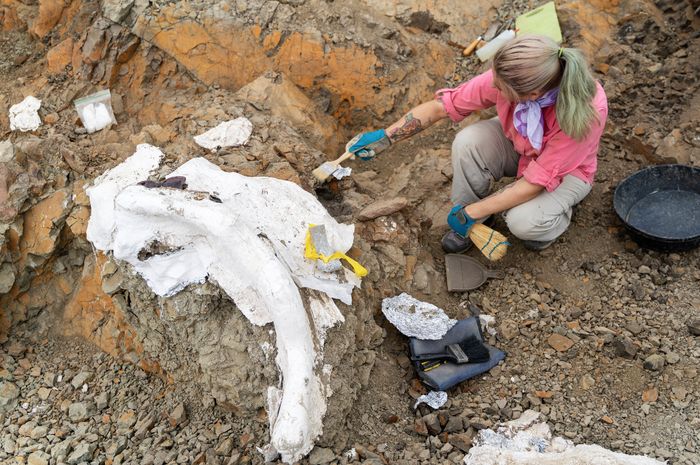BURKE MUSEUM
–
Kelsie Abrams, Burke Museum Fossil Prep Lab Manager, examines fossils from the Flyby Trike while excavating in northeastern Montana.
–
Nationalgeographic.co.id—A team of paleontologists from the University of Washington and the Burke Museum of Natural History unearthed four dinosaurs in northeastern Montana, United States this summer. One of the four fossils is probably the rare ostrich-like Anzu species.
In July 2021, a team of volunteers, paleontology staff, K-12 educators who were part of the DIG Field School program and students from the University of Washington and other universities teamed up to unearth the dinosaur. The fossils were found in the Hell Creek Formation, a geological formation that dates back to the last part of the Cretaceous Period, 66 to 68 million years ago.
Typical paleontological excavations involve excavating one known fossil. However, the Hell Creek Project is an ongoing research collaboration of paleontologists from around the world studying life just before, during and after the Cretaceous-Paleogene mass extinction event that killed all dinosaurs except birds. The Hell Creek project is unique in that it samples all plant and animal life found throughout rock formations in an unbiased manner.
The four fossils found were the first of an ilium, or hip bone, from an ostrich-sized theropod, a group of two-legged meat-eating dinosaurs that included Tyrannosaurus rex and Velociraptor. The second, the hips and legs of a duck-billed dinosaur. The third specimen, namely Triceratops consisting of his skull and other fossil bones. Lastly, specimens of pelvic bones, toe claws, and limbs from other theropods that may have been the rare ostrich-imitating Anzu, or perhaps a new species.
It is known that three of the four dinosaurs were all found near the Land Management Bureau’s land which is currently being leased to a rancher. All fossils will be taken back to the Burke Museum where the public can watch paleontologists move the surrounding rock in the fossil preparation laboratory.
Also Read: ‘Flying Dragon’ Fossil Found Preserved in Rock in Chile

Andrea Godinez/Burke Museum/University of Washington
–
Hell Creek geological formation.
–
“Every fossil we collect helps us sharpen our view of the last dinosaur-dominated ecosystem and the first mammal-dominated ecosystem,” said Gregory Wilson Mantilla, professor of biology and curator of vertebrate paleontology at the University of Washington’s Burke Museum in the release.
According to him, with the findings, we can better understand the processes involved in the loss and origin of biodiversity, fragility, collapse and formation of ecosystems.
Also Read: Snake Evolution Happens After Surviving a Dinosaur Killing Asteroid

BURKE MUSEUM
–
Close-up of the Flyby Trike’s occipital condyle bone dubbed
–
All dinosaurs except Triceratops will be prepared in the Burke Museum’s fossil preparation laboratory this fall and winter. The Triceratops fossil remains at the site as the excavation team continues to find more and more bones as they excavate and it takes additional time to excavate further bones that may be related to the surrounding rock. The team plans to complete the excavation by the summer of 2022.
The Triceratops was called the “Flyby Trike” in honor of the breeder who first discovered the dinosaurs when he flew his plane over his farm. The team has found fragments of this dinosaur, horn bones, individual ribs, mandibles, teeth and bones of the occipital condyle.
Also Read: Kurupi itaata, New Predator Dinosaur Found in Brazil

BURKE MUSEUM
–
Amber and fossilized seed pods were also found at the Flyby Trike site.
–

Timothy Kenney/Burke Museum/University of Washington
–
Kelsie Abrams, manager of the Burke Museum’s paleontological preparation laboratory.
–
Also Read: Dating from the Age of Dinosaurs, These Sea Creatures Are Still Alive!
The Flyby Trike was found in hardened mud, with the bones strewn on top of each other. The clues the researchers found, suggest that the dinosaurs may have died in floodplains and then mixed together after their death by being carried by floods or rivers, or perhaps moved by scavengers such as T. rex before they become fossils.
In addition, the Flyby Trike was one of the last Triceratops to live before the Cretaceous-Paleogene mass extinction. Burke’s paleontologist estimates he lived less than 300,000 years before this event occurred.
“Prior to this year’s excavations, some of the Flyby Trike fragments and their horns were collected and then prepared by volunteers in the fossil preparation lab. The fossil parts were collected in many pieces and put together fantastically by the volunteers,” said Kelsie Abrams, preparatory laboratory manager. the Burke Museum paleontologist who also participated in this summer’s fieldwork.
Also Read: Dinosaur Mummy Found, Has Intact Skin and Intestines
PROMOTED CONTENT
Featured Videos
– .


